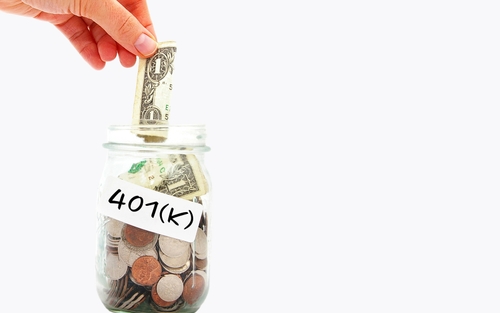Here is a scary statistic: More than half of us don’t have enough saved to cover a $1,000 unexpected expense.
Between the bills you must pay, high inflation, and stagnant wages, it can feel like there isn’t enough money left at the end of the month to set aside. But no matter where you’re at now, you can build an emergency fund this year.
How to Start Saving Money: Think Small
Creating a savings goal is the first step toward financial stability, but you don’t need to start with an overwhelming amount. While most financial experts recommend having six months’ worth of emergency savings, setting aside your first $100, $500, or $1,000 is still a worthwhile goal.
Once you have a goal, consider your budget and see what you can comfortably afford to put aside monthly. That number will help you determine a timeline for your goal.
Pay Yourself First
A simple yet effective way to make sure you save: Pay yourself first.
When we’re trying to save, we often move any money left over on payday or at the end of the month to our savings. While that is a good thing, it is all too easy to have nothing left over to put toward saving.
Instead, many financial experts recommend treating your savings account like another bill to be paid. When you’re paying bills, transfer your savings at the same time.
Choose the Right Savings Vehicles
One of the easiest ways to build an emergency fund is to make your money work harder for you. By choosing the right savings vehicle, you could grow your savings faster. Getting the best interest rate plays a big part in the decision, but there are other factors to consider to find the right place to stash your cash:
Consider Interest Rates
The first thing to consider is the interest rate. Start by comparing your basic savings account with high-yield savings accounts.
- Traditional Savings Accounts: Offered by most banks, these accounts provide a safe place to park your money. However, the interest rates are often lower compared to other options. Consider these for short-term goals and easy access to funds.
- High-Yield Savings Accounts: High-yield savings accounts offer more competitive interest rates. However, interest rates are variable and may increase or decrease over time.
- Certificates of Deposit: To open a CD, you’ll need a lump sum of cash. You’ll also need to lock it up for a certain period, ranging from several months to a few years. If you withdraw early, you may pay a penalty. However, CDs can offer higher interest rates than traditional savings accounts.
Fee Structure
Before signing up for an account, ensure you understand the monthly fee structure. Some accounts marketed as “free” may charge you for some transactions. For example:
- Monthly Maintenance Fees: Some savings accounts charge monthly fees, which can consume your savings over time. Look for accounts with minimal or no fees, especially if you plan to maintain a lower balance.
- Transaction Fees: Be aware of any transaction fees associated with your savings account. These fees may apply if you exceed a certain number of monthly withdrawals or transfers.
Accessibility
In an emergency, you want to be able to access your emergency fund quickly and easily. Consider these aspects:
- ATM Access: Consider the accessibility of ATMs associated with your savings account. If you anticipate needing to withdraw cash occasionally, choose an account with a network of ATMs convenient for you.
- Online and Mobile Banking: Ensure the savings account provides a user-friendly online and mobile banking experience. This is crucial for monitoring your savings, setting up automated transfers, and managing your account efficiently.
Minimum Balance Requirements
While some financial institutions will open a savings account for just a few dollars, others may charge a monthly fee if you don’t maintain a certain balance. It can run the gamut. Make sure you understand:
- Minimum Opening Deposit: Some savings accounts require a minimum initial deposit to open the account. Choose an account that aligns with your budget and doesn't impose a significant upfront cost.
- Minimum Balance to Avoid Fees: Be aware of any minimum balance requirements to avoid monthly fees. If the account mandates a balance that doesn't fit your financial situation, it may be worth exploring alternatives.
Account Security and Insurance
While most financial institutions are well-regulated and safe, it is still a good idea to ensure your money will be protected if the bank fails. Ensure your savings account is insured by the Federal Deposit Insurance Corporation (FDIC) or the National Credit Union Administration (NCUA). This protects your deposits up to a specific limit, enhancing the security of your funds.
Reviews and Reputation
Before committing to a savings account, read reviews and gather information about the bank's reputation. Look for feedback on customer service, ease of account management, and overall satisfaction. Not all banks are created equal.
Additional Account Features
While perks aren’t vital, it is nice to have a few extras that make banking easier. Consider:
- Automatic Transfers: Confirm that the savings account allows for easy setup of automated transfers. This feature is crucial for streamlining your savings strategy.
- Integration with Budgeting Apps: If you use budgeting apps, check if the savings account integrates seamlessly with these tools. Integration can simplify expense tracking and goal monitoring.
Automate Your Savings
Automating your savings takes the guesswork out of putting money aside. This ensures consistency and discipline in your savings habits, even during busy or challenging times.
- Schedule Automated Transfers: Most bank accounts offer the option to set up direct deposits and automated transfers between your checking and savings accounts. Choose a frequency that aligns with your budget, such as monthly or bi-weekly.
- Align with Paycheck Deposits: Bonus points if you schedule your automated transfers to coincide with your paycheck deposits. This ensures you save before you start spending.
- Leverage Employer Payroll Systems: Check if your employer offers automated payroll deductions for savings. Some companies allow employees to direct deposit a portion of their paycheck directly to a savings account, making the process seamless and efficient.
Cut Back on Some Expenses to Save More
Tracking expenses is crucial to identifying areas where you can cut back without sacrificing your quality of life. Look at your bank or credit card statements for the last few months. Look for places where you spend more than you think (brace yourself for a few surprises).
Once you know your spending, you can decide what to cut back on. When you make those cuts, allocate those funds to your savings account. It will build up over time, even if you only save a small amount.
While it's essential to be mindful of discretionary spending, cutting everything enjoyable may lead to burnout. It's okay to keep some indulgences in your life as long as you prioritize savings.
Stash Windfalls to Reach Your Goals Faster
Unexpected income, such as gifts, tax refunds, or work bonuses, can significantly boost your savings. Resist the urge to splurge immediately and allocate these windfalls directly into your savings or emergency fund.
Got a raise at work? Consider saving those extra bucks. Since you’re used to living without the increase, you could grow your savings faster without sacrificing your quality of life.
Look for More Ways to Save
Want to boost your savings? You may have to think creatively about your budget and change how you spend to get there. Try:
- Shop Smart: Use coupons, wait for sales, and compare prices for the best deals.
- Utilities and Subscriptions: Evaluate your utility bills and subscriptions regularly. Consider downgrading or eliminating services you don’t use often.
- Meal Planning: Plan meals to reduce impulsive spending on dining out or ordering in.
- Public Transportation: Explore public transportation options to reduce fuel and maintenance costs associated with owning a vehicle.
- DIY Projects: Learn basic repair and maintenance skills to tackle minor household projects, saving on service costs.
Remember, minor changes add up over time, leading to significant financial milestones. You don’t have to sacrifice everything that brings you joy to reach your savings goals. Look for small changes in your spending habits you can make without impacting your quality of life. If you stick with it, your emergency fund will grow.
Read Next: Lesson 3 — How to Manage Debt







